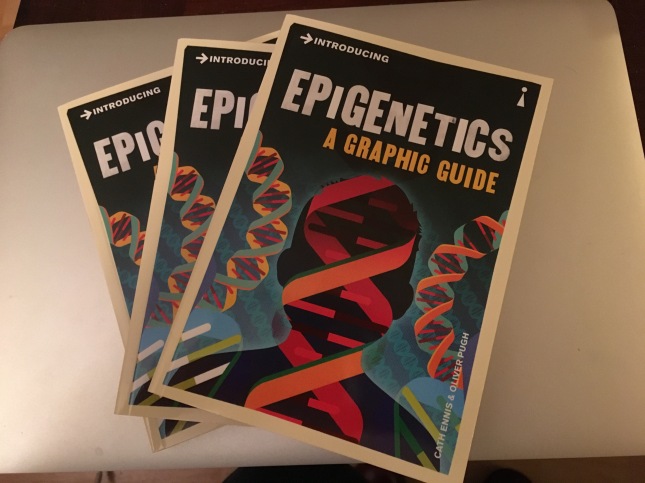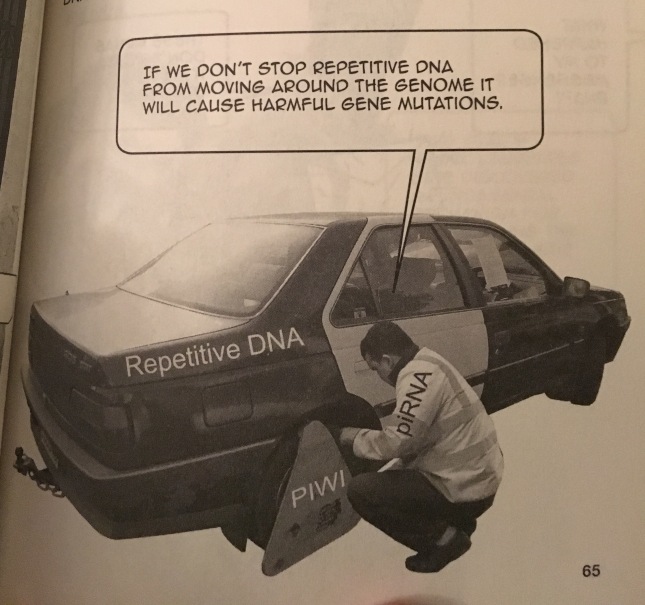(Originally published on Occam’s Corner at Guardian Science, in June 2014)
As explained in part 1, epigenetics — chemical modifications to DNA and proteins – can profoundly affect gene activity. But epigenetics also plays an important role in cancer, and research in this field may be opening up potential new treatment options.
There are many different types of cell in the body. With very few exceptions, our cells contain identical DNA, but have different levels of activity of each of the genes encoded in that DNA. A gene that’s switched on at low levels in the intestine might be highly active in the brain and completely silent in the liver. Epigenetic marks (chemical modifications of the DNA or of the histone proteins that bind it — see part 1) help to set and maintain the appropriate levels of gene activity for each cell.
Histone modifications are very dynamic, allowing for rapid changes to the activity of specific genes in response to outside stimuli; in contrast DNA modifications, primarily a mark called DNA methylation, are much more stable. The epigenetic mechanisms that regulate both kinds of marks are like cogs in a well-oiled machine, working together with other parts of the cellular apparatus to keep everything running smoothly.
Cells affected by diseases have abnormal levels of gene activity. For example, the activity of the various tumour suppressor genes that usually inhibit cell growth and division might be lost in a cancer cell, while pro-division genes might be hyperactive. The epigenetic marks and mechanisms found in such cells also look very different to those present in their healthy counterparts. In cancer cells, for instance, the overall amount of DNA methylation decreases as the disease progresses, even while specific parts of the DNA near important genes experience abnormally high levels of methylation; the patterns of histone modification observed in cancer cells also deviate more and more from the normal baseline over time.
There are also characteristic epigenetic changes in many inflammatory and autoimmune disorders, conditions associated with ageing, and many others. However, I’m going to focus on cancer in the rest of this article, since that’s the field I know best.
Epigenetic changes in disease: cause or effect?
A cancer cell is a chaotic beast. Freed from the multiple layers of regulation that usually control its growth and division, everything from its molecules to its movements is abnormal. Teasing apart the abnormalities that contribute to the chaos from those that are just collateral damagecaused by the chaos has proven to be a difficult problem to solve, and epigenetic abnormalities are no exception to this general rule.
It’s likely that many of the altered epigenetic patterns observed in cancer cells are just noise, a response to the chaos caused by other, earlier, changes. However, there’s evidence that in some cases epigenetic changes can actively contribute to the progression of the disease, and are sometimes even the very first event that sets a cell off on its path to malignancy:
- Changes to the activity of specific genes that are usually involved in controlling cell growth can sometimes be attributed at least in part to epigenetic changes. The BReast CAncer (BRCA) genes, and other examples of the tumour suppressor genes that usually control cell growth, are often silenced by DNA methylation in cancer cells; conversely, the epigenetic marks that usually keep pro-growth genes silent in normal cells can be removed in cancer cells.
- Mutations in proteins that create, remove, or bind to specific epigenetic marks have also been found in malignant cells; some of these mutations may even be the first alteration to occur in some types of cancers. For example, researchers (including some of my former and current colleagues) have identified a mutation in an epigenetic regulator protein called EZH2 in some types of lymphoma. The mutation changes the activity of EZH2, making it create more of a type of histone modification that’s associated with gene silencing. This seems to be a very early event in the development of these types of cancer. Mutations in other genes that are involved in forming, removing, or recognising specific epigenetic marks are also quite common in additional forms oflymphoma and other cancers.
Epigenetic therapies
There are two main targets when trying to reverse the epigenetic changes that contribute to the initiation and progression of cancer: the altered epigenetic marks themselves, and the abnormal proteins (such as mutated EZH2) responsible for initiating and maintaining these changes. In my last article, I compared the patterns of epigenetic marks found in different parts of the genome to using a pack of highlighters to mark up different parts of a text for different kinds of follow-up; to extend this analogy, epigenetic therapies try to either erase any coloured ink that has ended up on the wrong part of the text, or to fix the broken highlighter pen itself.
Given how hard it can be to distinguish epigenetic signal from noise in a cancer cell, and how critical epigenetic marks are to the normal function of healthy cells, the first of these two approaches – targeting the altered epigenetic marks found in cancer cells – is a more complicated and risky approach. Removing an epigenetic mark that’s present at abnormally high levels in cancer cells, but only as a reaction to the processes that are actually driving the progression of the disease, won’t effectively treat the cancer; decreasing the overall level of an epigenetic mark across the whole genome when only its effects on a couple of genes are actually important runs the risk of causing a lot of new collateral damage.
However, despite these difficulties it has been possible to design drugs that function by reversing global changes to DNA and histone modifications. Some of them are already in use, with many more in development.
The first such epigenetic-based cancer therapies to be approved are from a class known as histone deacetylase (HDAC) inhibitors. These drugs increase the overall level of a specific type of histone modification, and can reactivate some of the tumour suppressor genes that are silenced in certain cancer cells. The details of exactly how these drugs work are still being investigated (interestingly, their epigenetic effects may not represent the full story), but HDAC inhibitors have been shown to have a beneficial effect against some cancers, especially in combination with other therapies.
Drugs that reverse the gene silencing caused by DNA methylation in cancer cells are also in development, although at an earlier stage of the testing process. The benefits of these drugs are accompanied by the same kinds of side effects seen with other chemotherapy agents, but as the field matures and new classes of drugs enter the development pipeline, there is hope that these problems can be mitigated.
The second approach to epigenetic therapies – targeting the “broken highlighters” directly – mirrors a general trend in cancer therapy to develop drugs that target a specific protein. The goal is to drastically reduce the number and severity of side effects compared to those caused by traditional chemotherapy drugs, which are less precisely targeted and cause more collateral damage to the body’s healthy cells.
When a rogue protein (such as the form of mutated EZH2 seen in some lymphomas) is spreading epigenetic chaos in the cell, and when there’s good evidence that the resulting changes contribute to the progression of the disease, then inhibiting that protein would be expected to be an effective anti-cancer therapy.
Indeed, drugs that specifically block the function of the mutated EZH2 protein are in development. In early tests in cultured cancer cells and in mouse models, the EZH2 inhibitor reversed the altered pattern of epigenetic marks, restored the activity of the genes silenced by these marks, and slowed the growth of the lymphoma cells (NB my institution was not involved in this study).
Similar work is being done with the other “highlighter pens” that are known to often malfunction in cancer cells.
Given how long the drug development and testing process is, and how many potential drugs fail along the way, I’d call this a field with a lot of promise – in the long term. Researchers are still working out the details of how hundreds of proteins work together to set and maintain the patterns of epigenetic marks needed in a healthy cell, and the ability to tweak this complex machinery to turn a specific gene on or off at will is still a long way away. However, the ability to target and reverse the epigenetic chaos caused by mutations in specific epigenetic regulators is certainly a good place to start, and it’s encouraging to see such a relatively new field of basic research already reaching the clinic.
 The reality is that there is a broad spectrum of opinions about epigenetics, ranging from the purely pseudoscientific (e.g. your thoughts can stop or give you cancer) to believing the field to have little significance in the grand scheme of gene regulation to believing the theory of evolution needs to be rewritten because of epigenetics. Ennis does not shy away from some of these controversial ideas but does make sure to place the appropriate disclaimers.
The reality is that there is a broad spectrum of opinions about epigenetics, ranging from the purely pseudoscientific (e.g. your thoughts can stop or give you cancer) to believing the field to have little significance in the grand scheme of gene regulation to believing the theory of evolution needs to be rewritten because of epigenetics. Ennis does not shy away from some of these controversial ideas but does make sure to place the appropriate disclaimers.

 I’m very excited to officially announce that I have a new book coming out next year!
I’m very excited to officially announce that I have a new book coming out next year!


